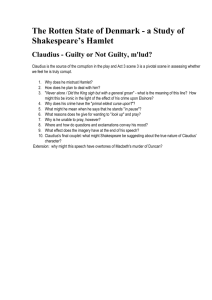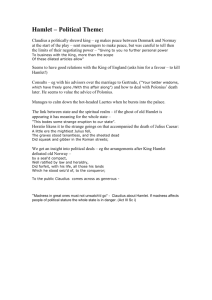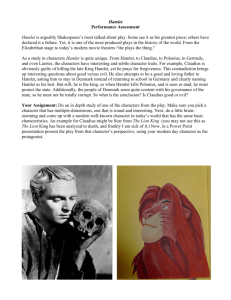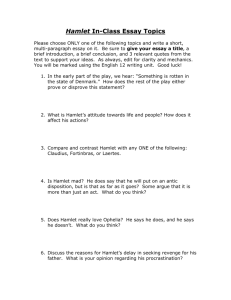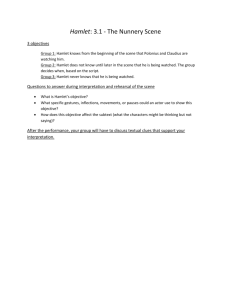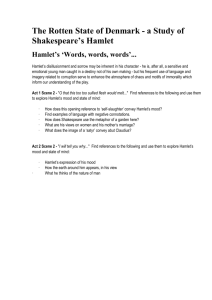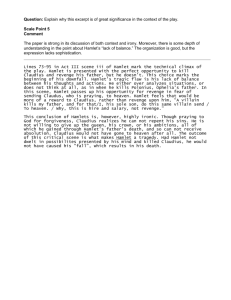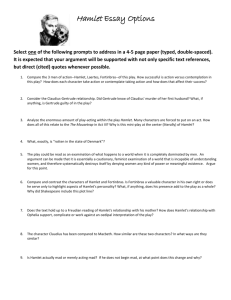THE DRAM OF EVIL: MEDIEVAL SYMBOLISM IN HAMLET
advertisement
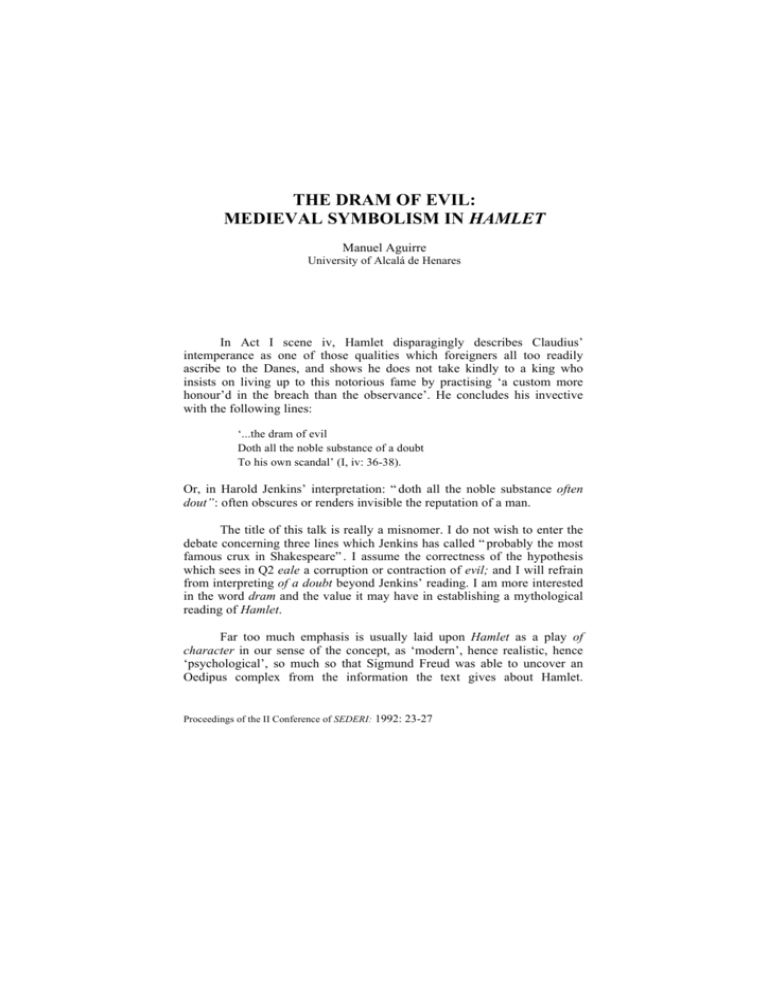
THE DRAM OF EVIL: MEDIEVAL SYMBOLISM IN HAMLET Manuel Aguirre University of Alcalá de Henares In Act I scene iv, Hamlet disparagingly describes Claudius’ intemperance as one of those qualities which foreigners all too readily ascribe to the Danes, and shows he does not take kindly to a king who insists on living up to this notorious fame by practising ‘a custom more honour’d in the breach than the observance’. He concludes his invective with the following lines: ‘...the dram of evil Doth all the noble substance of a doubt To his own scandal’ (I, iv: 36-38). Or, in Harold Jenkins’ interpretation: “ doth all the noble substance often dout”: often obscures or renders invisible the reputation of a man. The title of this talk is really a misnomer. I do not wish to enter the debate concerning three lines which Jenkins has called “ probably the most famous crux in Shakespeare” . I assume the correctness of the hypothesis which sees in Q2 eale a corruption or contraction of evil; and I will refrain from interpreting of a doubt beyond Jenkins’ reading. I am more interested in the word dram and the value it may have in establishing a mythological reading of Hamlet. Far too much emphasis is usually laid upon Hamlet as a play of character in our sense of the concept, as ‘modern’, hence realistic, hence ‘psychological’, so much so that Sigmund Freud was able to uncover an Oedipus complex from the information the text gives about Hamlet. Proceedings of the II Conference of SEDERI: 1992: 23-27 The Dram of Evil Without seeking to deny the validity of these approaches, I would like to emphasise, rather, the fact that many situations and images in the play constitute late manifestations or remnants, altered to whatever extent, of symbolic systems which predate Shakespeare by centuries if not millennia. Now, I have only got about fifteen minutes to make good this somewhat grand claim, so I shall limit myself to making a small contribution towards a mythological reading of the play. So, let me get back to the word dram. It derives from the Greek Drachm, a coin, and also a weight unit; from there, in the 16th century it began to be used to signify a fluid dram, a unit for measuring liquid weights. One of the earliest uses given by the OED for this sense is in the expression ‘a dram of poison’, found in Romeo and Juliet. In the play Hamlet, the word clearly has this sense: one drop of evil conduct suffices to obscure all virtues. This effect parallels that of Laertes’ poison, ‘So mortal that, but dip a knife in it, Where it draws blood, no cataplasm so rare ... can save the thing from death’ (IV, vii: 141 ff.). This in turn resembles that ‘thrice infected’ mixture which Lucianus pours into the Player King’s ears. Like the literal poisons, the metaphorical dram is part of that imagery of infection which pervades the play (Spurgeon, undated). To the poison I shall return later; now, this dram of evil which so perverts the nobility of a king does, by a process of metonymy deliberately employed by Shakespeare, also pervert the kingdom of which Claudius is the head, and the world of which this kingdom is a microcosmic image (see Aguirre 1990: 68, ff.); it therefore sums up one major theme of the play, its concern with a cosmic imbalance, with a time ‘out of joint’, with a major disturbance in the human universe. So much for the symbolic implications of the ‘dram of evil’. But what of its literal basis? In actual fact, the expression “ the dram of evil” is used by Hamlet at the end of and as a colophon to a long tirade a propos of Claudius’ carousing; its liquid connotations leave us in no doubt that Shakespeare is drawing a metaphor from the literal cup the king is quaffing. And as a consequence, all the connotations of this dram -infection, corruption, poisoning, subversion of the order of nature, etc.- revert to that innocent-looking cup, which thereby begins to appear as a most ominous symbol of all that is not right in Denmark and the human universe. 30 Manuel Aguirre Something about this cup is most unwholesome. So, what does it contain? What is Claudius drinking that not only sullies his character, his nobility, his ‘substance’, but equally corrupts the state of Denmark - and this, on the very night of the day when, through marriage, Claudius has acquired or confirmed his right to the Danish crown? There is much in the European medieval tradition which, properly examined, would help us explain the significance of this cup; but for plainness and clarity perhaps no literature is as explicit in this matter as the Celtic. An Irish story tells of how, when king Fingen of Munster died, his queen Mór Muman went to Cathal mac Finguine, because it was his turn to hold the kingship of Munster; ‘one day Cathal heard Mór mourning her former husband... He pointed out to her that it was not proper to weep for one who was dead, and she then promised to forget her dead husband and love the living’ (MacCana 1955-6:79). The story is an allegory for the process whereby the goddess of a given territory transferred the kingship from one ruler to another. We recognise here the argument appealed to by Gertrude and Claudius (and rejected by Hamlet) that ‘all that lives must die’ and that, therefore, the living must accept change just as the queen must accept a new consort. This tale is but one version of a theme which is not specifically Celtic but which yet appears most prominently in Celtic texts: the territorial queen, ultimately the earth-goddess, bestows Sovereignty on a chosen suitor. In Baile in Scail (= “ The Prophetic Ecstasy of the Phantom” ), King Conn meets a crowned woman who repeatedly offers him a golden cup while asking the question, ‘To whom shall the cup be given?’, whereupon the names of Conn’s descendants are given one by one. In Immram Curaig Mailduin (“ The Voyage of the Boat of Mael Duin” ) the hero reaches two islands on each of which a woman offers him food and drink; on a third island he meets a Queen who serves him in the same guise, after which she invites him to share her bed (for a detailed study of the symbolism in this tale, see Aguirre 1991a). In Echtra mac n’Echach (= “ The Adventure of Eochaid’s Sons” ) the young prince Niall goes in search of water and meets a repulsive old hag guarding the well; she demands a kiss in exchange for the water, and when Niall grants this she is transformed into a beautiful young girl who calls herself the Sovereignty of Ireland and proclaims Niall High King of Tara (for a discussion of this theme in connection with Chaucer’s Wife of Bath’s Tale, see Aguirre 1991b). 31 The Dram of Evil In the Irish and Welsh traditions, the theft of a royal goblet often symbolises the abduction of or sexual violence against the queen (Goetinck 1975: 135, ff.); and both events symbolise the challenge to the current king, or the conquest of Sovereignty by a rival king. The central image in this myth is that of the Queen’s dispensation of drink to her suitor as a symbol for her granting him Sovereignty; indeed, one of the Irish names for this queen-goddess is Medb, which relates to Welsh meddw (= “ drunk” ) and English mead, and means “ she who intoxicates” (MacCana 1955-6:78). And there is, of course, the matter of the Grail. Originally a descendant of such Celtic items as the Cup of Truth, the Platter or Horn of Plenty, or the Cauldron of Rebirth, the Grail first appears in Chrétien de Troyes’ unfinished Perceval, where a graal with a Host inside is brought by King Pelles’ daughter to the presence of Perceval, who must ask a question identical to that in Baile in Scail, ‘Whom does one serve with the Grail?’. This graal soon came to be interpreted in Christian terms as the chalice of Christ’s Last Supper, and thereby to acquire the peculiarly ‘patriarchal’ slant of Judeochristian myths; it is because of this new reading that later writers eventually substituted a youth or a priest for the figure of the maiden (Loomis 1959), thus reinforcing the Christian message and obscuring the original connection between vessel, woman, and Sovereignty. Curiously enough, the connection is retained in Shakespeare’s Hamlet: the cup symbolises both Claudius’ sexual union with the queen and the Sovereignty of Denmark. But, granted that the cup symbolises the Sovereignty of Denmark, how come it appears poisonous, evil, if it is such a sacred symbol? Because it has been stolen? But it is part of the myth that Sovereignty should be passed on, and this power transference is often symbolised by theft or sexual violence; these, precisely, were Claudius’ methods in Hamlet’s eyes: ‘he that hath kill’d my king and whor’d my mother’; it follows that the entire play is biased, has been given us through the eyes of a despondent prince who cannot resign himself to change, to the fact that ‘all that lives must die’ - indeed, who bears his father’s name, Hamlet, and is thus a representative of the old order. Nothing more natural, then, than that he should see in Claudius the source of an infection - the infection of change of life. 32 Manuel Aguirre But of course this is not all. That Hamlet is a paranoid does not mean Claudius is innocent of the crimes Hamlet suspects him of. To return to my starting-point: the king drinks, does so constantly; I count eight occasions when he is shown or mentioned in the context of drink; he seems to be always holding onto his cup, as if Shakespeare, consciously or not, were trying to convey an obsessive attachment to the Sovereignty the cup symbolises; Claudius himself is quite aware that the throne does not belong to him. It is this fact, as much as Hamlet’s own dark thoughts, that explains the metaphorical reference to the cup as containing a ‘dram of evil’: the traditional concept itself of the transmission of Sovereignty seems to have been perverted by two men neither of whom proves worthy of the crown of Denmark; the Cup of Sovereignty that should be a gift proves to contain poison. REFERENCES AGUIRRE, Manuel 1990: The Closed Space: Horror Literature and Western Symbolism. Manchester, Manchester U.P. AGUIRRE, Manuel 1991a: “ The Hero’s Voyage in Immram Curaig Mailduin” . Forthcoming in Etudes Celtiques, Paris. AGUIRRE, Manuel 1991b: “ A Link Between the Wife of Bath’s Tale and its (Disputed) Irish Source” . Forthcoming in the Proceedings of the 3rd International Conference of SELIM, held in Alcalá de Henares in September of 1990. GOETINCK, Glenys 1975: Peredur: A Study of Welsh Tradition in the Grail Legends. Cardiff, University of Wales Press. JENKINS, Harold (ed.) 1982: Hamlet. The Arden Shakespeare, Routledge, London 1990. LOOMIS, Roger Sherman 1959: “ The Origin of the Grail Legends” , in R.S.Loomis (ed.) Arthurian Literature in the Middle Ages: A Collaborative History. Oxford U.P. MACCANA, Proinsias 1955-6: “ Aspects of the Theme of King and Goddess in Irish Literature” , in Etudes Celtiques vii, pp. 76-114. 33 The Dram of Evil SPURGEON, Caroline F.E. (undated): Leading Motifs in the Imagery of Shakespeare’s Tragedies. Folcroft Library Editions, U.K. 1973. *** 34
